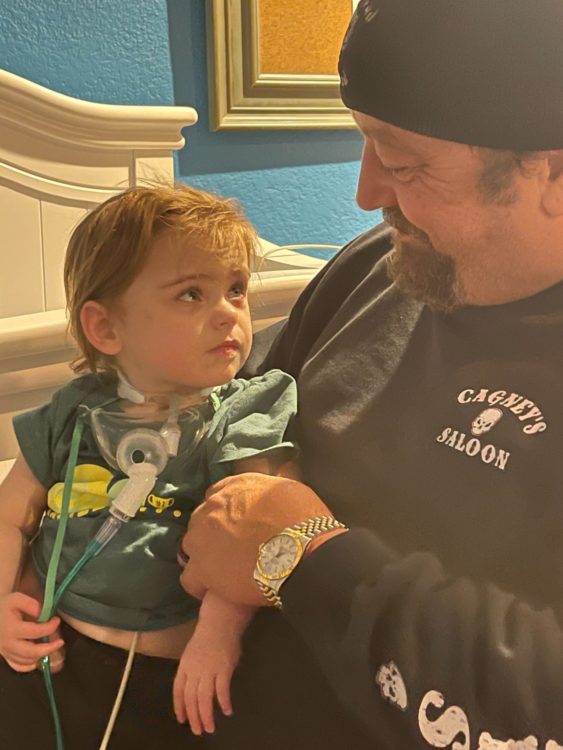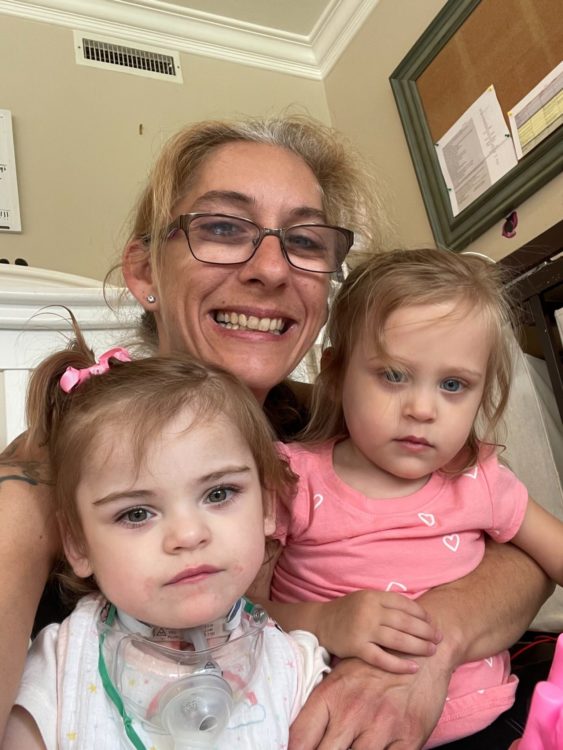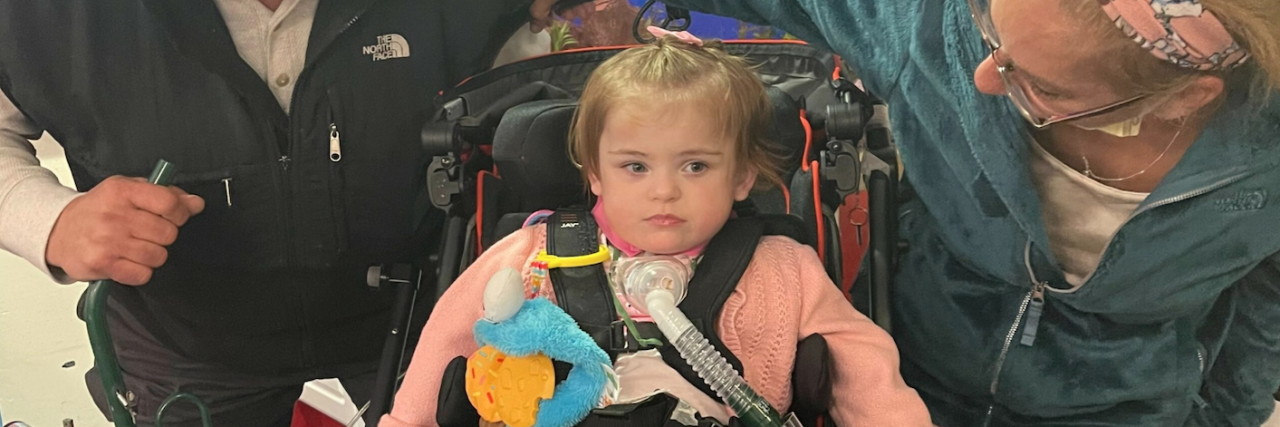Some Kids in Long-Term Care Facilities Didn’t See Parents for More Than a Year
When staff at All Saints Healthcare in North Hollywood told Nicole and Les Kozma that they could no longer visit their 1-year-old daughter, Ryanne, inside the facility’s pediatric nursing unit due to the COVID-19 pandemic, the couple assumed the restrictions would be fleeting.
For months, they’d traveled to the facility to visit Ryanne at least once a week from their home in Agoura Hills, juggling the two-hour roundtrip drive with caring for their other four children. Nicole Kozma relished getting to hold her tiny daughter. She ached to bring Ryanne home with her, but the child needed round-the-clock nursing care to recover from lung problems she developed after an extremely preterm birth.
The Kozmas were upset when the facility closed to visitors in March 2020, but they understood the risk COVID-19 posed to Ryanne and other medically fragile children there. Surely the facility would soon figure out a safe way for them to visit their daughter, they thought.
That didn’t happen.
For almost a year, according to Nicole Kozma, the only contact she and her husband had with Ryanne was through sporadic, 20 to 30-minute FaceTime calls, with the microphone muted on the facility’s side. Often there were no staff members available to help with the calls, and the Kozmas would wait weeks to speak with their daughter, she said. The facility did not respond to requests for comment.
“It was devastating,” said Nicole Kozma. “You’re thinking, is she going to know me when she comes home? Are we going to bond? All those things that happen when you have a baby… I didn’t get any of that.”
The Kozmas are not alone. Throughout the pandemic, medically fragile children in California’s pediatric long-term care facilities and their parents have endured drastic limits on their ability to see and interact with each other. Also called pediatric subacute facilities, some locations barred parents and other caregivers from visiting their children in person for over a year, citing virus safety precautions. Several parents told the California Health Report that they’d only been able to interact with their children over video chat or through a window, and even those opportunities were infrequent. A few facilities allowed parents to visit their children in an outdoor space, such as a patio, but virtual and in-person visits were generally limited to no more than an hour once a week throughout most of the pandemic, research by the California Health Report and disability rights advocates found.
Research shows that both institutionalized care and separation from parents can negatively impact children’s development, as well as their mental and emotional wellbeing. Advocates and parents said they’re concerned that visitation policies at pediatric subacute units during the pandemic may have caused long-term harm to kids, depriving them of meaningful contact with loved ones; increasing stress, isolation and trauma; and removing parents’ ability to effectively monitor their children’s care.
Even now, as some facilities loosen their visitor policies in response to widespread vaccination rates and new state guidelines, many still aren’t giving children enough time with their parents, advocates said.
“Knowing that there’s this set of children… who have had to go for an entire year with no or limited contact with a parent or guardian or other loved ones was really horrifying to learn,” said Nicholas Levenhagen, a senior attorney with the nonprofit advocacy organization Disability Rights California, which has been tracking the issue. “We’re concerned about the real harm developmentally, socially, mentally, educationally that’s occurred without that contact.”

Ryanne with her father, Les Kozma, after she was released. The family said they didn’t get to see her in person for almost a year. Photo courtesy of Nicole Kozma.
Falling through the cracks?
Pediatric subacute facilities care for babies, children and young people up to age 21 with complex medical conditions. These patients are stable enough not to need intensive care in a hospital, but too fragile to go home because they need round-the-clock nurse supervision. Some, like Ryanne, have tracheostomies—an opening in the neck for a tube that allows air to enter the lungs—and may rely on specialized equipment such as ventilators or dialysis machines to stay alive. Children can remain in these facilities for months or years, depending on their condition and the ability of their family to care for them. There are currently 10 pediatric subacute facilities in California, housing an estimated 350 children.
Visitation rules at pediatric subacute facilities varied prior to the pandemic, but overall family members could meet with children daily during broadly scheduled visitation hours. Then COVID-19 cases began to surge in California, and pediatric subacutes reacted similarly to nursing homes for seniors. They barred outside visitors and restricted children’s movements and activities within the facilities to limit the spread of infection. Indeed, guidelines the Centers for Medicare and Medicaid Services (CMS) issued in March 2020 advised senior nursing homes to restrict all in-person visitation, except in extreme situations such as if a person was dying.
Meanwhile, early in the pandemic, California’s Department of Public Health (CDPH) specifically advised hospitals to let children have visits from one parent or support person at a time, noting that “visitors are essential for the mental health of pediatric patients.” But it did not issue the same advice for children in pediatric subacutes. These fall under separate guidelines for long-term care facilities, which mostly serve seniors. In a June 2020 letter, CDPH told the state’s long-term-care homes to allow residents to have socially distanced outdoor visits with family members, but it did not provide specific guidance for children. The letter also said one family member could visit indoors, but only if certain criteria were met, such as declining COVID-19 case rates in the local community. At the time, the virus was still rampant in most of California.
Levenhagen said he believes pediatric subacute facilities fell through the regulatory cracks. Children are different from adults; having regular contact with family is critical to their wellbeing and development, so visits should have been allowed throughout the pandemic, he said. In March, Disability Rights California wrote to CDPH demanding an update to the guidelines to allow children “routine, ongoing, uninhibited contact with their parents.”
“The developmental harms to children isolated from their parents for months cannot be understated,” the organization wrote. “We ask that you immediately take action.”

Nicole Kozma holds Ryanne, left, and her twin sister, Valerie. The twins did not get to see each other in person while Ryanne was at a pediatric subacute facility during the pandemic. Nicole Kozma worries they missed out on crucial bonding time. Photo courtesy of Nicole Kozma.
Guidelines change
In April, CDPH issued updated guidelines for long-term care facilities, with specific requirements for children. The guidelines state that “visitation must be permitted for pediatric residents,” and that a facility’s “visitation program shall provide routine and ongoing visitation to meet each resident’s developmental and medical needs.” The exact length and frequency of required visits is not specified.
In an emailed response to questions, the CDPH press office said the guidance for long-term care facilities was always intended to apply to children, even before April, and noted the policies that allowed visitation under certain circumstances, such as for end-of-life care.
“Throughout this pandemic CDPH’s primary goal has been focused on ensuring the health and safety of residents at long-term care facilities,” the agency wrote. “(V)isitation with restrictions were allowed inside these facilities under certain criteria even before vaccines were available. Facilities were expected to follow these guidelines throughout the pandemic.”
Several pediatric subacute facilities did ease their visitation policies following the new guidelines. By the end of April, All Saints HealthCare, for example, was allowing up to three one-hour visits a week in person, and Totally Kids Rehabilitation Hospital in San Bernardino was allowing daily, one-hour visits. However, most visits still had to be prescheduled, and were limited to between three and seven hours per week. At least one facility still did not allow visitors at all.
On June 10, Disability Rights California sent another letter to CDPH stating that most visitation policies were still inadequate, and asking the agency to investigate.
“To us, routine and ongoing visitation really means that: routine and ongoing. Not for an hour a few days a week, but regular access to be able to see their kids as uninhibited as possible,” Levenhagen said.
Extreme stress
Heather Garcia of Moreno Valley first learned she could no longer visit her 2-year-old son, Giuseppe, at the Children’s Subacute Center Community Hospital of San Bernardino in March 2020, when she went there to drop off clean clothes for him. According to Garcia, a staff member stopped her at the door and told her visitors were now barred because of COVID-19.
“We’ll contact you,” Garcia said she was told.
Garcia had been visiting Guiseppe every day since he was hospitalized in early 2019 due to a brain injury he suffered after almost drowning. Yet, for the next several months, she couldn’t see her son or get any significant information about his wellbeing, she said. Every day she would call the facility multiple times to ask about him. Staff rarely answered the phone, she said.
“I would cry every day. I didn’t know what was happening with my son,” she said. “I fell into a depression. I started seeing a therapist. I got prescribed medication for my depression and anxiety; I started gaining weight because I was stressed out.”
About six months into the pandemic, Garcia said the facility allowed her to start seeing Guiseppe on FaceTime for about 10 minutes a week. He looked unkempt and unhappy, she said. Only in March 2021, was she finally allowed back into the facility to visit him in person.
“A whole year that I missed out on my son,” she said angrily. “Whoever wrote the guidelines messed it up. You shouldn’t take away my rights to see my son. I never lost custody, I never hit my child, I don’t do drugs, I don’t drink… This isn’t fair for the kids and parents.”
The California Health Report attempted to reach the facility multiple times, but was unable to get through.
‘It wasn’t up to us’
Most pediatric subacute facilities declined to comment for this story or did not respond to requests for an interview. However, Steven Kang, director of staff development at Healthbridge Children’s Hospital in Orange, which has a subacute children’s unit, said his facility shut down visitation to protect its vulnerable residents from infection, and that this followed guidelines put out by state and federal health authorities. Healthbridge didn’t allow in-person visitation until early February, he said, but parents could schedule visits with their children over video or phone for up to two hours at a time. He said the facility has one activities person to schedule visits for 25 patients.
“It wasn’t up to us… We were just following the recommendations,” he said. “At that point in time the virus was still very, very widespread, and we couldn’t tell whether people had the virus or not, so in order to prevent us from compromising our patients we just had to close the visitation down.”
Healthbridge is now allowing families to schedule in-person visits three times a week for up to two hours at a time. Only two visitors are allowed simultaneously.
Raelene Walker, president of the American Academy of Pediatrics California chapter representing northern and central California and medical director of a children’s hospice program in Santa Cruz County, said that kids’ visitation needs have been overlooked during the pandemic. This has caused “unintended consequences of significant harm,” she contends. One child with developmental disabilities who Walker treats was unable to see his mother for months except over Zoom, she said.
“It was incredibly traumatic for him, and for his mother. He had regression of many of his behaviors,” she said. “I was appalled to read that there were places that didn’t even allow Zoom.”
Prioritizing kids
Parents who spoke with the California Health Report said pediatric subacute facilities could have taken action much sooner to allow in-person visitation during the pandemic, such as implementing strict COVID testing requirements, transferring children to private instead of shared rooms for visits, and offering regular visits outdoors.
“I see no reason why they couldn’t have outdoor visits if people are wearing masks and keeping 6 feet of space; that really should be enough,” said Marisa Ring of Los Angeles, who was unable to visit her 3-year-old son, Sage, for months at Whittier Hospital Medical Center. Thinking about him being alone in a hospital bed made her feel “so much pain and anxiety,” she said.
For the Kozmas,getting to see Ryanne is no longer a problem. The couple were able to remove their daughter from All Saints Healthcare on March 23 after completing training to take care of her at home with a ventilator.
Now 2 years old, Ryanne is starting to crawl and play. Her health is improving, and although she still needs supplemental oxygen, she no longer depends on a ventilator to breathe. But Nicole Kozma wonders if Ryanne’s development would be farther along if she hadn’t spent months at a facility unable to see her family. Kozma said the child also missed out on her regular physical and occupational therapy because of COVID-19 restrictions.
“I think definitely, definitely because they were strict on all their rules, that she didn’t get the proper care at all,” said Kozma. “Us not visiting her (and the reduced physical therapy) put her on the path of slowing down her progress.”
This story originally appeared on California Health Report.
Lead photo courtesy of Nicole Kozma

